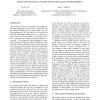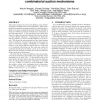327 search results - page 44 / 66 » How to Evaluate Social Intelligence Design |
CSCW
2002
ACM
13 years 8 months ago
2002
ACM
Supporting awareness of others is an idea that holds promise for improving the usability of real-time distributed groupware. However, there is little principled information availa...
CSCW
2000
ACM
14 years 1 months ago
2000
ACM
Video-based media spaces are designed to support casual interaction between intimate collaborators. Yet transmitting video is fraught with privacy concerns. Some researchers sugge...
TON
2010
13 years 3 months ago
2010
Dense deployments of WLANs suffer from increased interference and as a result, reduced capacity. There are three main functions used to improve the overall network capacity: a) in...
WSC
1997
13 years 10 months ago
1997
One of the key issues in reasoning with multiple interacting intelligent agents is how to model and code the decision making process of the agents. In Artificial Intelligence (AI...
ATAL
2010
Springer
13 years 9 months ago
2010
Springer
This paper analyzes the worst-case efficiency ratio of falsename-proof combinatorial auction mechanisms. False-nameproofness generalizes strategy-proofness by assuming that a bidd...


